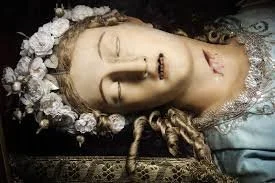St Victoria
I wanted to explore the story of St. Victoria next, as she was the first Virgin Martyr I encountered during my travels around Rome in the last few years. I was part of a group from my university’s Catholic Student Center touring Rome, and we visited the church called Santa Maria della Vittoria. This church is famous for displaying Bernini’s statue of St. Teresa’s Ecstasy. I remember, as crowds marveled at the magnificent statue of St. Teresa, I turned around and noticed this incorrupt saint lying directly across from the sculpture. No one else seemed to notice her, crowds had their backs to her, and I felt compelled to pray by her and learn her name and story. The placard by her body told me her name was St. Victoria of Anticoli.
St. Victoria’s incorruptible body was covered in the typical wax casing that you often see with saints, but this casing had its flaws. Although she is adorned with a beautiful blue regal dress and a crown of flowers, her skeletal remains can be seen through gaps in the wax around her teeth and parts of her hand. I’ve attached some photos of her below.
St. Victoria was a beautiful noblewoman in the early Church, living in Italy under Roman pagan rule. She and her sister, St. Anatolia, were arranged to be married to wealthy pagan men who were upset to discover that their betrothed were Christians. According to legend, St. Victoria initially planned to go through with the marriage, hoping to convert her fiancé, while St. Anatolia refused hers outright and dedicated herself fully to God. Eventually, inspired by her sister’s courage, St. Victoria followed suit.
From there, the sisters’ stories become even more dramatic and painful. Their suitors received permission to imprison them in their homes in an effort to convince them to renounce the Faith. St. Anatolia was martyred first, after an executioner failed to kill her and converted instead, her suitor took her life himself. When St. Victoria’s suitor heard of this, he became desperate to sway her. Over the years that followed, he alternated between kindness and abuse, hoping to manipulate her into abandoning Christ. She remained unwavering. Finally, in a fit of rage, someone (either her suitor or an executioner) stabbed her. After her death, the man was instantly struck with leprosy and died shortly after, reportedly eaten by worms.
St. Victoria’s story offers us a powerful witness of authentic femininity. She lived out a kind of strength that goes far deeper than the surface. She wasn’t loud or dramatic in her resistance, she simply endured, quietly, for years. We often think of strength as something outward, but St. Victoria shows us the kind of feminine strength that is deeply interior: the strength to suffer, to remain faithful, and to love even when it costs everything.
One of the first things that stands out in her story is her faithfulness to Christ, the true Bridegroom of her soul. Her refusal to marry wasn’t about rebellion, it was a deeper yes. She longed to make a total gift of herself to the One who had first loved her. Authentic femininity, at its heart, is receptive and life-giving. St. Victoria teaches us that our deepest calling is to receive God’s love and respond with a gift of our whole selves.
Her incorrupt body also speaks volumes. Despite the decay, her beauty shines through: the blue dress, the crown of flowers, the dignity of a daughter of God. In a culture obsessed with outward beauty, her body reminds us that holiness is the most radiant beauty of all. Virtue is what lasts.
Her bond with her sister, St. Anatolia, is also a beautiful example of spiritual sisterhood. Anatolia’s courage inspired Victoria’s transformation. It’s a reminder that the way we live our faith matters, not just for us, but for the women around us. True femininity doesn’t compete; it calls others higher.
Finally, St. Victoria’s life reminds us that martyrdom isn’t always quick or visible. Sometimes it’s quiet, slow, and hidden. Many of us will never be asked to die for our faith, but all of us will be asked to live for it. To say no to relationships that don’t honor our dignity. To endure suffering we didn’t choose. To hold onto Christ when it would be easier to let go. St. Victoria shows us what it means to remain rooted, receptive, and faithful, even in the dark.
I can’t imagine the pain she must’ve endured, hearing of her sister’s death and then continuing to be imprisoned and mistreated for years. And yet, her quiet perseverance became her greatest witness. She didn’t preach. She didn’t give in. She stayed. And in doing so, she revealed a strength that still speaks centuries later.
Reflection Questions
Where in my life am I being invited to a deeper faithfulness to Christ, even when it’s difficult or hidden?
Are there any relationships or attachments in my life that I need to surrender to God in order to remain faithful to my dignity and identity as His beloved?
Do I see strength as something loud and visible, or can I recognize and honor the quiet strength of perseverance and inner trust in God?
How am I being called to support and inspire other women in their walk with Christ, like St. Anatolia did for St. Victoria?
What does true beauty mean to me? Am I cultivating the kind of beauty that reflects virtue, holiness, and love?
Have I experienced moments of “hidden martyrdom”, times when I’ve had to die to self silently for the sake of love, truth, or fidelity? How did God meet me there?
May we, like the Virgin Martyrs, live with courage, purity, and unwavering love for Christ.
With hope in His victory,
Maria
Innocentiae Flos, Martyrum Corona



